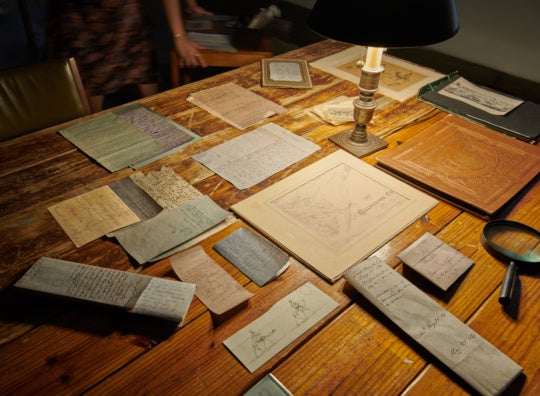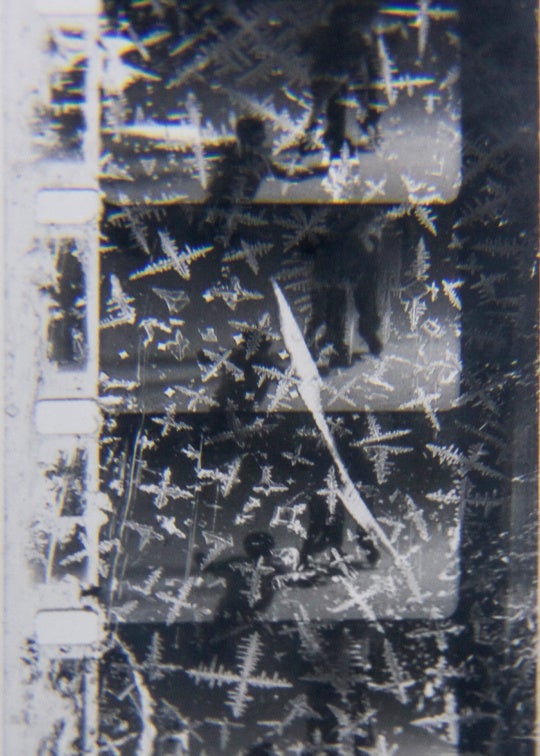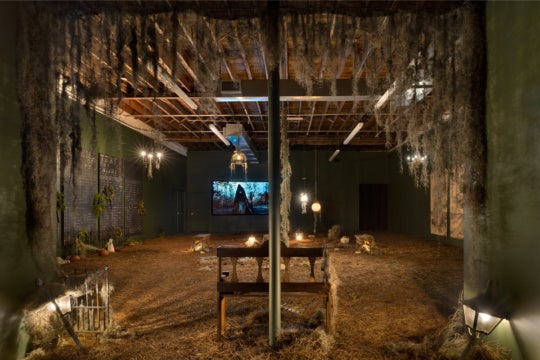
Atlanta artist Nancy Floyd has been photographing herself pretty much every day since 1982. She calls the unedited collection of over 2,500 photos a visual calendar—titled “Weathering Time”—one that shows how she has aged over the years.
Floyd, who teaches photography at Georgia State University, was recently awarded the 2015 John Gutmann Photography Fellowship for this series, which will be presented in a show this fall at the Hagedorn Foundation Gallery.
A Texas native, Floyd received a BFA in studio art from the University of Texas at Austin, an MA in photography from Columbia College in Chicago, and an MFA from the California Institute of the Arts.

Susanna Darrow: So, you’ve been working on your series “Weathering Time” for 33 years?
Nancy Floyd: I’m into my 34th year now. I was 26 when I started. I go anywhere from taking no pictures a month to, now, maybe 15. I don’t know if I’ve ever gone over 15 in the last 10 years.
When I started, I only had one room in a house and my camera. When I would wake up in the morning, I felt like my camera was staring at me because it was on a tripod in the corner. So, the more convenient it is for me, the more pictures I take. That’s one of the differences you notice when looking at them: the environments change. Now, I have a house with a studio downstairs. So, photos from the last 10 years have mostly been taken in the studio.
SD: I like that there’s a mix of the photographs solely depicting you juxtaposed with images of your family. It’s really lovely.
NF: You get to see how my nieces grew from being infants to young adults and then on to having children. I grow from being young to the dawn of my old age. And my parents grow old and die. I was just recently telling a friend how wonderful it is to watch my nieces and nephews grow up and change, but, at the same time, I’m also witnessing my siblings and I grow older and seeing the physical problems that come with that. I’m the youngest of six, but my sister is in her 70s, so it’s an interesting transition from being, like, “oh, this is fun to see these pictures” to “oh god, she can’t walk anymore.”

SD: Was there a specific timeline as to how regularly you would process the film?
NF: When I was a graduate student, I would get nervous every three or four months. When I had access to a darkroom, I would process the film, but I wouldn’t make contact sheets; I’d just put them away. In 2008, I went four years without processing any film and, out of that, some of the film was underdeveloped. So, now I’m back to doing it at least once a year. Recently, I’ve been doing reenactment photographs.
SD: I’ve noticed that—there are originals and newer versions.
NF: That started when my friend Steve and I tried to pose in the same way. I also wanted to do a reenactment with my husband [Robin]. In the book, there will be a series of him and me. But, in the exhibition, you have to work at finding it.
SD: So, they’ll be laid out together in the book. It’s nice to see the day-by-day progressions that happen when seen serially. But it’s also really interesting to see how general locations and appearances change with time.
NF: There are some, from the first months of the project, that were taken horizontally instead of vertically. I don’t know why I did that. You’ll see where the mistakes happen when the images are displayed in the show. In some of the pictures, I’m not in the frame. When the pets misbehave or my parents misbehave or my family misbehaves—these are times when I play around with the camera. Things like that are fun to discover. The differences are more visible in the book. For instance, I capture one room from every place I’ve lived. I call that series “My Room.”
SD: This is great. The work has very clearly evolved from your student days to the present. It’s documenting you, but it’s also documenting the years and the days and everything that goes on.
NF: It’s also a visual diary. For the first three years, I took notes about who was in the photos with me, thinking that I might forget their names. After 15 years, I quit the project for two years before I started it back up again. This was ’90-’93: there’s a few months of ’90 and a few months of ’93 but a nice big long chunk of nothing.
SD: How old were you then?
NF: 31-33. It’s interesting, because in the last 15 years, my body has really started to change. My skin is starting to sag; my face looks different. It happens slowly, but if you look at the early images compared to the later ones, you’ll see that.
SD: As you’ve been compiling this show, how has it been to see the entire project unfold?
NF: One of the things I’m struggling with right now is finding a very succinct way to express how I feel about this work. There’s quite a few things going through my head, not about personal issues, but about how I’m imagining the way the audience will receive the work. I haven’t really thought about the work in this way. It’s a new pace, and I find it really difficult.
SD: It’s a visual diary you’ve done for years now. Did any photos trigger emotions that you weren’t really aware of at the time?
NF: The photos with my dad when he’s in the hospital bed at the house. I remember asking, “Dad, is it okay if I take pictures?” “Yeah,” he responded—he always liked being in my photographs. Now, when I look at the photographs, I really see the pain. Someone who is dying, who we knew we were going to lose, agreed to be in these pictures. My sister and I were smiling. It’s odd—we are smiling with my dad and he’s dying. I called it the death shock—you try anything to laugh and to make light of things because everything is so hard. About 2 weeks ago, I looked at a photo of my mom and dad, my dog Ripley, and me and realized that I’m the only one still alive in that picture. That’s the heaviness that happens now. The first 20 years, it was fun and exciting. But now, something else comes up in it.
SD: When you’re in your 20s and starting a series like that, you don’t think about the things that are going to inevitably come up because they seem so distant and far away from. But, when you’re 33-34 years closer to death, the experience becomes more real.
NF: We’re all going to die, but no one talks about it. Who wants to talk about it? It’s not something that makes us feel good. So, when you look at work that shows death or people dying, viewers are presented with what happened at that specific moment when the camera clicked. That fleeting second. When you look at them later, you can reflect on them in a way that you can’t with paintings or other kinds of visual media. We always look at a photograph as the true subject. It’s not a photograph of Nancy: it’s Nancy. Looking at these photos now that I’m older, I’m like, “Oh, that’s rougher than I thought it was or used to be.” I don’t feel like I’m going to die tomorrow, but it is different; there’s a transition.
Class plays a part in this. My parents were poor—they lived in a mobile home. But, I was living in college dorms or old houses or whatever. Furniture changes—when my husband’s mother died, we inherited a lot of rugs and furniture that was fancier than what we previously had.
SD: So the settings changed.
NF: And my siblings married. I have two siblings who married Mexican-Americans, so all of a sudden we’re not all white anymore.
SD: That would be an interesting larger cultural project to see the shift in. I’m curious as how to this relates to your other portrait series?
NF: As an undergraduate, I was really influenced by the German portrait photographer August Sander. In his photographs, Sander was documenting people, mainly workers, which wasn’t what the Germans wanted in the 1930s. He was trying to make a document measure of people. They are pretty much straight on with a little camera tilt; it’s really descriptive. I did a portrait series on nuclear power workers and their families, which I wanted to have this sort of Sander’s clinical look. They are about letting the person and the environment say things as opposed to me giving the viewer some dramatic camera angle. Most of the time, they were in their houses, so the context you’re seeing them in is really different from their job setting. In some respects, it’s anti-aesthetic. The less dressed up it is, the more I like it. I’m pretty anti-drama. I like quiet portraits. I like photography that I engage with in a less manipulative way but that has an awareness of the photographer’s choice to take it at that moment: I see this as a documentary style.
SD: Did you intend for “Weathering Time” to be a project like this, showing all of them together? Is it more important to you as self-documentation or as something to be displayed?
NF: I don’t think I thought very much about it when I started. I just thought it was a neat idea. I thought it would be exhibited as contact sheets, enlarged contact sheets. I also thought about Roland Barthes’s book Camera Lucida, about the photograph of his mother and the way he felt about looking at her when she was younger, so maybe there was something there.
In ’84, when I was in graduate school, we were given an assignment that involved shooting 25 rolls of film in a week. One day, I didn’t know what else to shoot. I could take pictures but I refused to be taking pictures—I wanted to have some kind of thought process. I thought, “Well, I’ve got to do something so I’m going to show myself growing older.” So, I did this series of photographs where I made lines and smudges with my eyeliner. It’s a failed attempt because I was only 27 years old—I wasn’t going to look older. I remember I was reading a lot, too. Jan Grover was my professor in art history, which is when I first learned about feminist writings and the way that the female body performs.
I don’t like to smile; I don’t like to entertain or feel good about looking at my body. I’m not going to pose nude in these pictures. Although, I tell a story in the book about when I did take a picture of myself in my underwear when I was 56 years old, and how I really don’t want viewers to see that picture. That’s what’s interesting for me to think about now: the female body and my refusal.
SD: Do you want your viewers to have to work for it as well?
NF: Men my age don’t stand in their underwear either. It’s not like the aging body is something people want to see. I’ve heard people say, “why doesn’t that man put his shirt back on?” You hear that all the time about older men, so there’s an age thing that happens. But there’s another part of me that just wants to wear my underwear for, like, two years as an act of defiance.

SD: At this point, do you think your work is more about the female body or the aging body?
NF: I talk about it now as aging because it’s been 34 years. But the first 20 years, in terms of the way that I look at the work, it’s not about aging.
SD: When do you think that shift happened?
NF: It happened as soon as I started seeing differences. You see me gain weight and lose weight. When I get really happy, I tend to gain weight. And when things are rough, I lose weight. But it’s when you physically begin to see the big differences that it becomes more about the aging body. I’m getting close to getting over the shock of seeing my body change over time.
Why would I say to someone, “watch myself grow older?” Photographers have always taken photographs of themselves. Why are we doing this? What is our fascination? Do we want to go back in time? There’s this philosophical thing about how we can somehow transport ourselves back there. In photography, we are bringing back memories. So do we want to transport ourselves back in time? Do we just want to have that warm fuzzy feeling we had back then? I think we want the warm fuzzy feeling because we don’t go back to bad pictures of ourselves. In family snapshots, you throw the ones away that didn’t look good. There’s a curiosity and fascination with our looks and how we relate to ourselves over the years, as well as how we relate to our family over the years. The title, “Weathering Time,” signifies aging. But if you look at a shorter span of years, then the work is about other things.
SD: Psychological, emotional …
NF: I hadn’t thought about it that way originally. It wasn’t about aging at the beginning. Now it really is about the demise of me. It will go on until I’m gone. If someone could take a picture of me at the end, then the last picture and the first picture will be of me.
SD: Has doing this series impacted how you handle other portraits? Has it made you reconsider the way that you frame them or generally how you perceive your subjects?
NF: I understand how the photographs misrepresent me, just as my photographs of others sometimes misrepresent them. I teach photography, so I understand that something happens in the photographs.
SD: The photos where you are recreating a scene have a performative aspect to them. Do you feel like they all do in a way? Do you feel like your performing a little bit in all of them? If you were a male photographer, this would be a very different conversation.
NF: I remember one semester asking my photo students if any would pose nude for themselves. Few would volunteer, yet those who did were women. My male friends in photography school didn’t pose nude. Women always did. I wonder if a man who started the project when I did would have the same idea, if we would have had the same rules, or how different it might be.
SD: Are you the object of your own gaze in this case? Does that come up?
NF: I think it does. Is it narcissistic? I don’t think so. It’s about looking at me. I don’t wear makeup in any of these pictures except for when I’m dressed up for Halloween. I try to reveal everything in my photographs.
SD: You kind of regained some agency by doing it to yourself.
NF: I also did a series of photographs with male nudes. I think that any nude in the landscape just looks silly, male or female. It just didn’t do anything for me. I photographed my boyfriends and strangers. In the end, it just wasn’t an interesting aesthetic. I thought, “Why am I doing this?” The only reason was because men did it to women. I have no interest in my male nudes. Robin gets uncomfortable sometimes. He doesn’t like to be in them but sometimes he agrees to be in them. Our culture is about looking at women. In some respects, I am fighting against that because I don’t smile, dress up, or those sorts of things. It wouldn’t have been interesting if I did.
SD: I think you really notice the progression along the way, as well.
NF: It’s a lot about feminism and being the object of the gaze. I’m really starting to think about them as photographs and what they’re about and looking at the history of self-portraiture and asking that question: “Why do I want to show you this?” A lot of my work, I never show to anyone; I think a lot of artists do the same. I make work for myself first; this project was for myself.
My work is like reading a visual book. I’m interested in the idea of history and things being gone and replaced by the present. It’s memory time travel. It’s fascinating to see how a landscape changes over time. It might be this idea that we can’t experience time—we are in the moment. It’s one way we use our minds: like reading a book, you can imagine things.
It’s a body of work but it’s only one photograph; it’s one big photograph of me.
Susannah Darrow is a cofounder and the executive director of BURNAWAY.

This project is supported by the Georgia Humanities Council and the National Endowment for the Humanities and through appropriations from the Georgia General Assembly.






